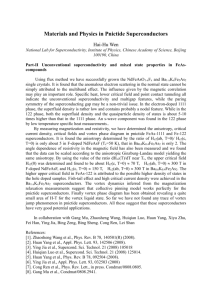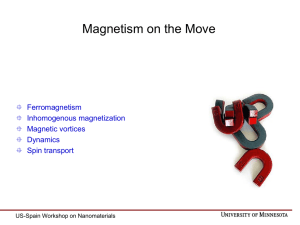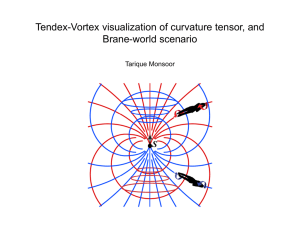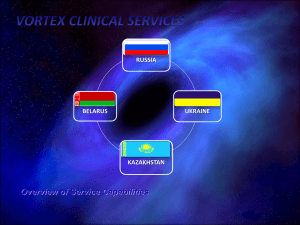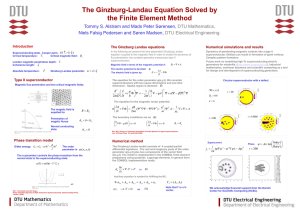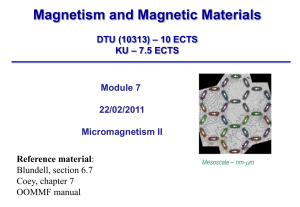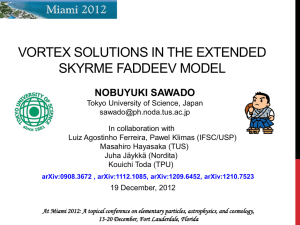Muon Spin Rotation technique and its application in
advertisement
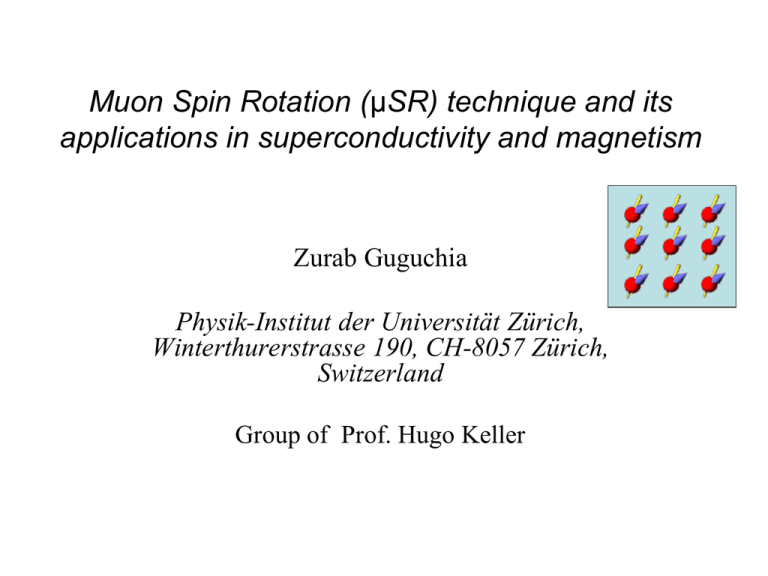
Muon Spin Rotation (µSR) technique and its
applications in superconductivity and magnetism
Zurab Guguchia
Physik-Institut der Universität Zürich,
Winterthurerstrasse 190, CH-8057 Zürich,
Switzerland
Group of Prof. Hugo Keller
Outline
Basic principles of the μSR technique
Vortex matter in cuprate superconductors
Multi-band superconductivity in high-temperature
superconductors
Magnetism and superconductivity
Low-energy μSR and applications
Conclusions
Thank you!
University of Zurich in collaboration with:
• Paul Scherrer Institute (PSI)
Laboratory for Muon Spin Spectroscopy
Laboratory for Developments and Methods
• Tbilisi State University
Prof. Alexander Shengelaya
• ETH Zürich
• IBM Research Laboratory Rüschlikon (Zurich)
• Max Planck Institute for Solid State Research, Stuttgart
• EPFL, Lausanne
• Institute of Low Temperature and Structure research,
Poland
• Brookhaven National Laboratory, Upton NY
Paul Scherrer Institute (PSI)
photons
All experiments presented in this talk were performed at
Paul Scherrer Institute, Villigen (Switzerland)
Basic principles of the μSR technique
Some properties of the positive muon
Property
Value
Rest mass mμ
105.658 MeV/c2
206.768 me
0.1124 mp
Charge q
+e
Spin S
1/2
Magnetic moment μμ
4.836 x 10-3 μB
3.183 μP
Gyromagnetic ratio γμ /2π
135.5387 MHz/T
Lifetime τμ
2.197 μs
Muon production and polarised beams
Pions as intermediate particles
Protons of 600 to 800 MeV kinetic energy interact with protons or
neutrons of the nuclei of a light element target to produce pions.
p p p n
Pions are unstable (lifetime 26 ns).
They decay into muons (and neutrinos):
The muon beam is 100 polarised with Sµ antiparallel to Pµ.
Momentum: Pµ=29.79 MeV/c.
Kinetic energy: Eµ=4.12 MeV.
Muon decay and parity violation
Muon-spin rotation (μSR) technique
Sµ(0)
Bμ = (2π/γμ) νμ
Muon-spin rotation (μSR) technique
N F (t ) N B (t )
N F (t ) N B (t )
A0 P ( t ) A ( t )
Bμ = (2π/γμ) νμ
TRIUMF http://neutron.magnet.fsu.edu/muon_relax.html
Advantages of µSR
Muons are purely magnetic probes (I = ½, no quadrupolar effects).
Local information, interstitial probe
complementary to NMR.
Large magnetic moment: μµ = 3.18 µp = 8.89 µn
sensitive probe.
Particularly suitable for:
Very weak effects, small moment magnetism ~ 10-3 µB/Atom
Random magnetism (e.g. spin glasses).
Short range order (where neutron scattering is not sensitive).
Independent determination of magnetic moment and of magnetic volume
fraction.
Determination of magnetic/non magnetic/superconducting fractions.
Full polarization in zero field, independent of temperature
measurements without disturbance of the system.
Single particle detection
extremely high sensitivity.
No restrictions in choice of materials to be studied.
Fluctuation time window: 10-5 < x < 10-11 s.
unique
The µSR technique has a unique time window for the study
of magnetic flcutuations in materials that is complementary to
other experimental techniques.
μSR in magnetic materials
1.0
homogeneous
Muon Spin Polarisation
0.8
0.6
0.4
0.2
0.0
-0.2
-0.4
-0.6
-0.8
-1.0
0
1
2
3
4
5
6
7
8
9
10
7
8
9
10
Time ((s)
s)
time
inhomogeneous
Muon Spin Polarisation
1.0
0.8
0.6
0.4
0.2
0.0
-0.2
-0.4
-0.6
-0.8
-1.0
0
1
2
3
4
5
6
Time (s)
time
(s)
Courtesy of H. Luetkens
amplitude → magnetic volume fraction
frequency → average local magnetic field
damping
→ magnetic field distribution / magnetic fluctuations
Vortex matter in cuprate superconductors
Type I and type II superconductors
Flux-line lattice (Abrikosov lattice)
B
elementary flux quantum
h
o =
= 2 .0 6 7 x 1 0 -1 5 V s
2e
SR local magnetic field distribution p(B)
in the mixed state of a type II sc
Bext
Bext
Since the muon is a local probe, the SR relaxation function
is given by the weighted sum of all oscillations:
P(t)
Ô
o
Ó
è ®
þ
;
Ž -
o
Í •
{ 6
‘>
ð «
°
ð ˆ
½
ý €
ž
w }
½
ð ý
¯
Ì €
}
ó
½
.
;
O
, Æ
×
ã
u t
Î è
?
Þ
%
½
Á
Ê Ó
þ
þ þ
Â
© W
Õ
ª
- Ã
º
½
õ ]
ø ø
ž
˜ Î
Œ
˜
Ù þ
þ „
þ
~
˜
¸
ð
o þ
þ
ø Ó
ë
” ¡
'?
¹
{
¶ v
˜
„ w
ü ý
þ
Á ¼
þ
ø þ
þ
[
K
½
Î ~
½
μSR time spectra
þ
ó 'U
å
•
¦ ž
Ö
¼
Í ½
;
½
= þ
›
þ ~
½
Ì
þ
˜
Þ „
Ô
Þ þ
þ
Þ {
˜
(
¾
_ g
ë b
¸
\
Ó
O
° E
Æ
m
ž þ
ß
Á ý
˜
Ø
ý ˜
þ
þ Œ
þ
Ø
Þ €
 Æ
 ù
{
~
ç Ê
ª ˆ
‹
ð ž
Þ þ
ð
Ý ð
× ý
Ô
˜
k
˜
ˆ þ
ý
s š
ô ó
Ð
Í
æ
˜ y
ç
¹
Ì
1
O
ž
þ Ð
Ô
Ô
½
Ý
ð ´
½
ü
8K
0.1
0
Y B a 2 C u 3 O 6.97
-0.1
50 m T (F C )
0.2
A sym m e try
76K
T < Tc
0.1
0
-0.1
0.2
120K
0.1
T > Tc
0
-0.1
-0.2
0.2
0.6
0.4
Time ( s)
0.8
μSR technique
Determination of the magnetic penetration depth
Bi2.15Sr1.85CaCu2O8+δ
B ext // c
B ext = 10mT
T = 5K
p (B )
12
8
BSCCO 2212
second moment of p(B)
B ext
2
4
0
0
12
5
B ext // c
10
B (mT)
15
20
Gaussian distribution p(B)
B ext
B ext = 150mT
T = 5K
BSCCO 2212
p (B )
-4
B
8
2 1/2
2
B
1 / ns / m*
: SR relaxation rate
4
0
140
145
150
B (mT)
155
160
Melting of the vortex lattice
high-T c type
superconductor
normal
phase
m a g n e tic in d u ctio n B
B m (T )
B c (T)
2
vortex
liquid
phase
vortex
solid
phase
B c (T)
1
Meissner phase
temperature T
Tc
H
Bi 2.15 Sr 1.85 CaCu 2 O 8+
(a)
30
5.2mT
5.0K
20
Vortex lattice melting
10
p (B )
,
0
(b)
45.4mT
63.8K
54.0K
40
20
0
-5
0
B in t - o H e xt (m T )
5
Lee et al., Phys. Rev. Lett. 71, 3862 (1993)
Lineshape asymmetry parameter α
“skewness parameter”
vortex solid
vortex liquid
p(B)
p(B)
<0
>0
B
B
Tm
T
¥
ƒ
B ‘° ,
• ±
(
A • õ
Å ¶ t Æ
W
- - 4 ’Ô
µ
†
]
ë
á
£ } È
%
7
§ ð &
= $ ] Ö + £ A
e ø ¶
e
ª • µ Y §
ß ã '
C Å ˜
© q F ¸
°
e „
W
ñ Å †
%
•
ß — ! •
§ Ü Æ
Ò < L µ
ü ì
Â
ê U
£ %
§ Ä
~
ç
q °
â Š
Ù
†
Á
^ ß
ã
r
Ì -
G
ù
• þ
¶ å
Ù Q
 Ö
Ü
3
\
ƒ A
°
§ «
‡ •
7
‹
’2
ï
Ï µ
Æ
Ì
·
š
Ú ß
d
%
q Õ
Ö
Œ
6
Q
§
¨ $
Ö
ß
Å -
§
¶ ©
• Õ
ï
M
ß
BSCCO (2212)
Vortex lattice melting
1.0
ske w n e ss p a ra m e te r
0.5
vortex
solid
vortex
liquid
0
Tc
Tm
-0.5
45.4mT
-1.0
0
60
40
temperature (K)
20
80
vortex solid
100
vortex liquid
p(B)
p(B)
<0
>0
B
B
Tm
T
Lee et al., Phys. Rev. Lett. 71, 3862 (1993)
Magnetic phase diagram of BSCCO (2212)
600
Bi 2.15 Sr 1.8 5 CaCu 2 O 8+
0µH0H
e ext((mT)
x m
t
T
)
400
Bm SR
B cr S R
Bm SANS
Bdp S AN S
m e ltin g lin e B m (T )
2D
disordered
vortex
solid
vortex liquid
200
0H c
B cr
0
2
3D ordered vortex solid
0
20
40
T (K)
Aegerter et al., Phys. Rev. B 54, R15661 (1996)
60
80
Aegerter et al., (1998)
Multi-band superconductivity
in high-temperature superconductors
Nb-doped SrTiO3 is the first
superconductor where two
gaps were observed!
Two-gap superconductivity in cuprates?
Nature 377, 133 (1995)
T-dependence of sc carrier density and sc gap
Low temperature dependence of magnetic penetration depth reflects
symmetry of superconducting gap function
Two-gap superconductivity in single-crystal La1.83Sr0.7CuO4
sc 1 /
2
ab
d-wave symmetry (≈ 70%)
Δ1d(0) ≈ 8 meV
s-wave symmetry (≈ 30%)
Δ1s(0) ≈ 1.6 meV
Khasanov R, Shengelaya A et al., Phys. Rev. Lett. 75, 060505 (2007)
Keller, Bussmann-Holder & Müller, Materials Today 11, 38 (2008)
Two-gap superconductivity in Ba1-xRbxFe2 As2 (Tc=37 K)
SR
Δ0,1=1.1(3) meV, Δ0,2=7.5(2) meV, ω = 0.15(3).
Guguchia et al., Phys. Rev. B 84, 094513 (2011).
V. B. Zabolotnyy et al., Nature 457, 569 (2009).
Magnetism and superconductivity
Phase diagram of EuFe2(As1-xPx)2
TSDW(Fe) = 190 K
TAFM(Eu2+) = 19 K
Z. Guguchia et. al., Phys. Rev. B 83, 144516 (2011).
Y. Xiao et al., PRB 80, 174424 (2009).
Z. Guguchia, A. Shengelaya et. al., arXiv:1205.0212v1.
Phase diagram of Ba1-xKxFe2As2
X. F. Wang et al., New J. Phys. 11, 045003 (2009).
E. Wiesenmayer et. al., PRL 107, 237001 (2011).
Phase diagram of FeSe1-x
Zur Anzeige wird der QuickTime™
Dekompressor „“
benötigt.
Bendele et al., Phys. Rev. Lett. 104, 087003 (2010)
Low-energy μSR and applications
Low-energy SR at the Paul Scherrer Institute
E. Morenzoni et al., J. Appl. Phys. 81, 3340 (1997)
Depth dependent µSR measurements
B ( z ) B ext exp( z / )
B(z)
superconductor
B ext
0
z
Jackson et al., Phys. Rev. Lett. 84, 4958 (2000)
More precise: use known implantation profile
Jackson et al., Phys. Rev. Lett. 84, 4958 (2000)
Direct measurement of λ in a YBa2Cu3O7- film
muon energy (keV )
6.9
3.4
10
15.9
20.9
24.9
29.4
9
p e a k fie ld B ( m T)
8
7
6
5
T (K)
20
50
70
80
4
3
0
20
40
(nm)
146(3)
169(4)
223(4)
348(6)
60
80
100
120
140
160
muon implantation depth z (nm)
Jackson et al., Phys. Rev. Lett. 84, 4958 (2000)
Conclusions
The positive muon is a powerful and unique tool to explore
the microscopic magnetic properties of novel superconductors
and related magnetic systems
μSR has demonstrared to provide important information on
high-temperature superconductors, which are hardly obtained
by any other experimental technique, such as neutron
scattering, magnetization studies etc.
However, in any case complementary experimental
techniques have to be applied to disentangle the complexity of
novel superconductors such as the cuprates and the recently
discovered iron-based superconductors
Thank you very much
for your attention!
Question 1: How the distance between the vortices
depends on the applied magnetic field in case of
square/hexagonal lattice?
d
d
Question 2: Magnetic field at the centre of the
vortex can be calculated as follows:
H (0)
0
2
2
(ln K 0 . 18 );
K
.
Derive the formula for the energy corresponding to
the unit volume of the vortex.
Question 3: Why the scenario (a) is preferable for the
system?
0
0
(a)
n0
(b)
Question 4: What was the first experiment which
confirmed the presence of the superconducting gap?
Melting of
ice
ice
water
p
p m (T)
Clausius-Clapeyron
water
(liquid)
ice
(solid)
S = V
T
dp m
dT
Local Magnetic Flux Distribution p(B)
p(B)
<B>
• first moment
<B>=
• second moment
2
< B > =
• third moment
3
< B > =
B
<B>
•B p(B) dB
2
< B >
•(B - < B >)
2
p(B) dB
< B 3>
•(B - < B >)
3
p(B) dB
Melting of the vortex lattice
3D vortex solid
0H
3D vortex liquid
0 H m (T)
Clausius-Clapeyron
vortex
liquid
vortex
solid
S = - M 0
T
dH m
dT

